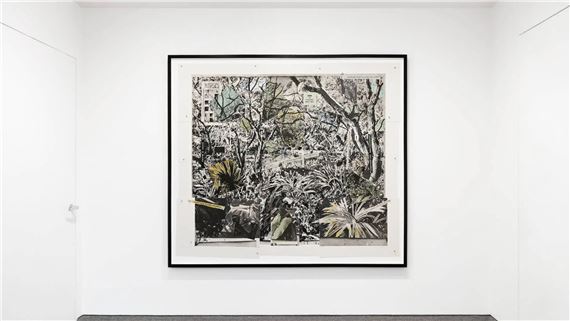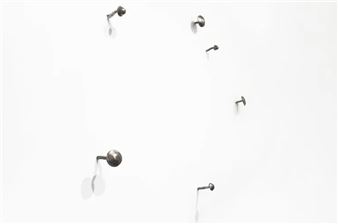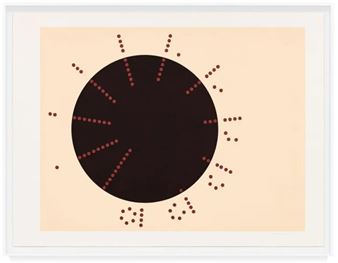One Wall One Work: William Kentridge
For artist William Kentridge, mishearing is a key creative and philosophical principle, representing the way the human mind constructs meaning from uncertainty. In KentridgeвҖҷs practice, misunderstanding and mistranslation are not failures, but fruitful moments that generate new ideas and narratives. In an often-told story, Kentridge, as a child, misunderstood about his fatherвҖҷs work as a defense attorney for Nelson Mandela in the South African Treason Trial (1956вҖ“1961). Kentridge misheard it as вҖңtrees and tilesвҖқ due to a mosaic-tiled table and the fir trees at his family home. This memory became a powerful metaphor for understanding the world through fragments and pieces, connecting the private experience of childhood to the public sphere of political events.
In KentridgeвҖҷs distinctive tree and garden works, individual sheets of paper are assembled like tiles to form the overall images, often incorporating fragmented texts. The scenes represent not just the nature depicted, but also the complexities of knowledge and history, as well as concepts of growth, decay, and interconnectedness. The spaces depicted also serve as a canvas for fragmented texts, drawn from literature and poetry, further reinforcing the idea of a multi-faceted understanding of history, memory, and the world at large.
The work currently on view at Krakow Witkin Gallery, вҖңHow to Explain Who I Was,вҖқ is the latest of the artistвҖҷs large-scale works to challenge notions of veracity, completeness, and comprehension. By employing numerous different methods of reproduction (photography, photogravure, photopolymer, and drypoint etching) onto 52 sheets of seven different types of paper collaged and pinned together, Kentridge has created a scenario where various types of distinct marks, imagery, size, image source, and paper are considered equally. Photos of pins holding a piece of paper in the studio have the same relevance as actual pins holding the exhibited piece together. A photogravure of a photograph of a charcoal and India ink drawing is overlayed with direct drypoint marks. Like in much of KentridgeвҖҷs work, вҖңrealityвҖқ is subjective, incomplete, reformulated, and expanded in poetic ways where parts, parts left out, and the sum of the parts are equally significant.
вҖңIt shows that the uncertainty and the doubt that is central to the studio practices are also ways of understanding the limitations of our understanding of the world and our certainties about the world, and makes a long-term argument for doubt, for being careful about being too certain on any judgments and understanding that all of these understandings of all of our understanding of different parts of the world are constructions that we make from incomplete fragments.вҖқ

Recommended for you
For artist William Kentridge, mishearing is a key creative and philosophical principle, representing the way the human mind constructs meaning from uncertainty. In KentridgeвҖҷs practice, misunderstanding and mistranslation are not failures, but fruitful moments that generate new ideas and narratives. In an often-told story, Kentridge, as a child, misunderstood about his fatherвҖҷs work as a defense attorney for Nelson Mandela in the South African Treason Trial (1956вҖ“1961). Kentridge misheard it as вҖңtrees and tilesвҖқ due to a mosaic-tiled table and the fir trees at his family home. This memory became a powerful metaphor for understanding the world through fragments and pieces, connecting the private experience of childhood to the public sphere of political events.
In KentridgeвҖҷs distinctive tree and garden works, individual sheets of paper are assembled like tiles to form the overall images, often incorporating fragmented texts. The scenes represent not just the nature depicted, but also the complexities of knowledge and history, as well as concepts of growth, decay, and interconnectedness. The spaces depicted also serve as a canvas for fragmented texts, drawn from literature and poetry, further reinforcing the idea of a multi-faceted understanding of history, memory, and the world at large.
The work currently on view at Krakow Witkin Gallery, вҖңHow to Explain Who I Was,вҖқ is the latest of the artistвҖҷs large-scale works to challenge notions of veracity, completeness, and comprehension. By employing numerous different methods of reproduction (photography, photogravure, photopolymer, and drypoint etching) onto 52 sheets of seven different types of paper collaged and pinned together, Kentridge has created a scenario where various types of distinct marks, imagery, size, image source, and paper are considered equally. Photos of pins holding a piece of paper in the studio have the same relevance as actual pins holding the exhibited piece together. A photogravure of a photograph of a charcoal and India ink drawing is overlayed with direct drypoint marks. Like in much of KentridgeвҖҷs work, вҖңrealityвҖқ is subjective, incomplete, reformulated, and expanded in poetic ways where parts, parts left out, and the sum of the parts are equally significant.
вҖңIt shows that the uncertainty and the doubt that is central to the studio practices are also ways of understanding the limitations of our understanding of the world and our certainties about the world, and makes a long-term argument for doubt, for being careful about being too certain on any judgments and understanding that all of these understandings of all of our understanding of different parts of the world are constructions that we make from incomplete fragments.вҖқ
Artists on show
Contact details


 ARTISTS
ARTISTS














